The extensive breakfast in the Kreuzberg monastery takes place in a large hall. About 50 guests have stayed there. Hans says goodbye to me and we wish each other well. I get out my hiking map, which I ordered from the Rh÷nklub in Fulda, and set off on the descent from Kreuzberg. I had already prepared the route in Zurich. It's not quite so easy to cycle down this side. The Jakobsweg would be too steep, and there are no roads or cycle paths. But the small forest roads I have chosen prove themselves in practice. Over the Guckpass I come to an asphalt road that takes me to Langenleiten. The bright sun has dissolved the morning chill along with the clouds. The weather is beautiful. In the church of Langenleiten I find the statue of St James and there is also a pilgrim's stamp. Via Stangenroth I go to Burkardroth. There, a large group of pilgrims with music and flags marches towards Kreuzberg. The way of the cross leads to Frauenroth. There I come across the shell signs again. My guidebook tells me that there is a beautiful Gothic tomb in the small Romanesque church. I would like to see it. But it is Sunday and there is a mass going on. I sit down in the last row and sing and pray along until the service is over after the final hymn, the Marian song and the concluding organ music. As the people stream out, I go forward to the altar. Behind the altar in the choir is the beautiful Gothic tomb with the figures of Otto and Beatrix from the Bodenlaube. My joy is great.
Guckpass
At the Guckpass, on the left in the picture, my descent from Kreuzberg ends on forest road.
A beautiful tarred road brings me to Langenleiten. It runs parallel to the Way of St. James.
Langenleiten

St. James in the parish church Mariae Ascension of Langenleiten
Via Stangenroth and Burkhardroth, the trail leads slightly uphill to Frauenroth.
Frauenroth
Cistercian church Frauenroth. Built in 1231 by the knightly couple Otto and Beatrix von Bodenlauben. Otto was a crusader and minstrel.
The founding legend of the Cistercian monastery is interesting. Beatrix's veil flew away when she was thinking about founding a monastery. It was a sign from God, she thought, and had the veil searched for and the monastery built on the spot where it was found. Similar stories are told about the founding of the monastery of Klosterneuburg near Vienna. Agnes' veil was involved there.
The tomb of Count Otto von der Bodenlauben and his wife Beatrix of Courtenay, c. 1244, is one of the most important sculptures of the 13th century.
Wäre Christi Lohn nicht so voll Süsse,
so verliess ich nie die liebe Fraue mein,
die ich immerdar in meinem Herzen grüsse
und mein Himmelsreich soll sie mir sein.
Wo auch immer weilt die Gute,
Herr behalte mich in Deiner Hute,
Dass ich mir erwerb die Gnade Dein.
Otto von Bodenlauben; Minnegesang für seine Frau Beatrix
If Christ's reward were not so full of sweetness,
I would never leave the dear wife of mine,
Whom I'll ever greet in my heart
And she shall be my heavenly kingdom.
Wherever dwells the good one,
Lord keep me in Thy care,
That I may acquire the grace of Thine.
Otto von Bodenlauben; Minnegyrics for his wife Beatrix
On the river Saale
Back in the saddle, I cycle uphill and downhill towards Aschach. There I turn onto the Saale cycle path to Bad Kissingen. The path leads romantically past an old mine and a mill.
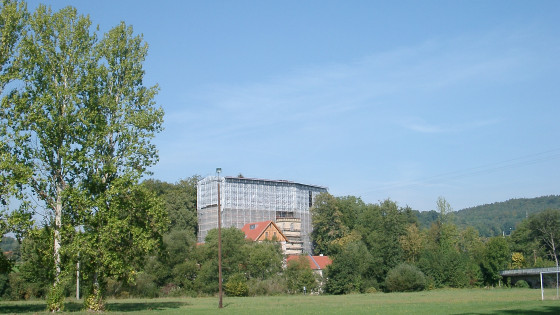
Castle in Aschach
Cycle path in the Saale valley
I cycle along leisurely. A young, sporty cyclist overtakes me. I increase my speed and ride with him. We talk a little. He is from Bad Kissingen for his morning training. It's getting narrow and I'm riding fast in the slipstream. "Watch out for a tight right-hand bend" he warns me, and sure enough, after a bridge, the cycle path branches off at a right angle. The speedy ride leads to a small village, through a gate. There is a lot of bumping. Me and the bike are shaken up. The ride is too wild for me. I let my guide pull me along and cycle leisurely to Bad Kissingen, which I reach 15 minutes later. The cycle path leads over an elegant bridge and the spa town with its rose garden lies before me. Time to take a photo. Where is the camera? It is not in its usual place in my handlebar bag and the zip of the bag is open. The shock goes through my limbs. I could get over the camera, but all the photos! Horrible. Desperate, I set out to find the camera. I ride back and search the ground. I look suspiciously at every oncoming cyclist to see if they have my camera. I also ask some if they have seen a camera. Nothing. I ride on, further and further back. My desperation increases. I stop at the place where there was such a good rumble. It is a dry ford that has caused the rumble. Nothing, nothing at all. How much further should I go back. It is pointless. I give up and turn around. There's a white stool next to a house. And there's my camera on it and the memory chip on top of it. Does it still work? I put the chip back in and photograph the stick.
The "Stockerl" (stool)
Es geht und alle meine Fotos sind auch noch da. In der Nähe ist eine Bank. Da setze ich mich erst mal hin, kann mein Glück nicht fassen, sende ein Dankgebet in den Himmel und telefoniere mit meiner Frau Vreni.
Thanks to St. James and his helper!
Back at the bridge in Bad Kissingen, I take pictures and make a mental note to always close the zip on the handlebar bag.
Bad Kissingen
Bad Kissingen is bustling with activity. There are spa guests and participants from a seminar who populate the town at lunchtime. In front of the town hall, a woman explains the figures on the fašade. A large crowd of tourists listens and I also discover the mischievous figures that I would not have noticed otherwise. I look for a restaurant in the square. All the tables outside are occupied. I ask two ladies if they are still free. Of course there is! One woman is taking part in an esoteric congress, the other is her mother, who is taking the opportunity to spend a holiday in Bad Kissingen. When I want to order the lentil dish advertised on a blackboard, the mother advises me to have something else. She had noticed how another guest was not at all satisfied with the lentil dish. An interesting conversation develops. A third woman, also a congress participant, joins us. She notices that I have not received a salad with the menu I have just ordered and asks the waiter for one.
It's a pity I have to leave the lovely, sunny Bad Kissingen again. Not without first taking a look at the Jakobskirche, where a music rehearsal for a wedding is taking place. Trumpet and organ play schmaltzy heartbreak music.
I continue along the Main-Saale cycle path. Up to Poppenhausen, the course corresponds to that of the Way of St. James. The cycle path takes me to Schweinfurt. Thanks to the good telephone description of the hostel mother, I find my way to the pilgrims' hostel "L÷wenzahn" and am warmly welcomed there. The hostel, which is also an excellent vegetarian restaurant, is marked with scallop shells on the outside. In my room I find pictures of the Spanish Way of St James. The hostel can accommodate six pilgrims. The rooms are simple, but modern and clean. Unfortunately, there was no shower in 2006. Only in the toilet was a tiny washbasin (note: a shower will be available from mid-2009).
Here is the entrance to the pilgrims' hostel in the "L÷wenzahn" restaurant, Gartenstadtstrasse 37, Tel. 09721/201130 Homepage
I take the bus to the city centre. There is a festival going on. A huge stage is set up at the town hall square. A band is playing music from the 50s. I am thrilled, buy a beer and stay there for a while. Back at the pilgrims' hostel, which is also a restaurant (vegetarian), I read the menu and decide on chanterelles. But the order is different. The nice woman comes and says: "For you there is a pilgrim menu, salad, spaghetti, mineral water and a glass of pilgrim wine". When I reply: "I'd rather have the chanterelles," the woman says: "I'll see if that's in the pilgrim menu. And sure enough, I get the pilgrims' menu with delicious chanterelles.
Schweinfurt
The Protestant St. John's Church on Martin Luther Square is Schweinfurt's oldest building. The construction of a Romanesque choir and the north tower began in the last quarter of the 12th century.
The town hall was built between 1570 and 1572 by master builder Nikolaus Hofmann from Halle a. d. Saale. It survived all wars undamaged.
The oriel tower is decorated with the imperial double-headed eagle with the coat of arms of Emperor Maximilian II, who holds the Schweinfurt eagle in his fangs. The balcony front is decorated with the coats of arms of the seven electors of the empire. The west and east gables of the town hall, as well as the bay window on the market fašade, are adorned with a colourful crowd of allegorical figures. These symbolise qualities such as justice, moderation and strength, or seasons, professions and elements.
Lanes in the old town of Schweinfurt
Rathaus, von der Seite gesehen
The armoury was built between 1589 and 1591 to serve as an arsenal and warehouse for the imperial city of Schweinfurt.
During attacks, the north and west sides of the building were particularly exposed, as they faced the city wall. The northern and western side of the armoury is thus designed to be three times as thick as the eastern and southern house wall. It has a width of 1.10 m.
Music from the 50s on Schweinfurt's town hall square.
"The Rocky Fellers" play for you
"jump jive and wail" (abridged version)
Such a great, lively musical accompaniment for my stage beer was nowhere else to be found.
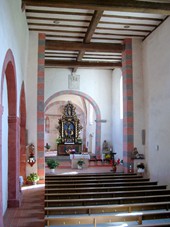
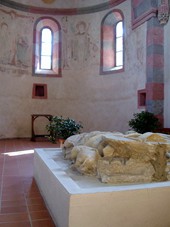

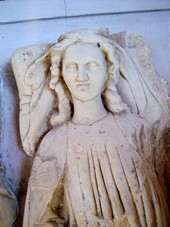
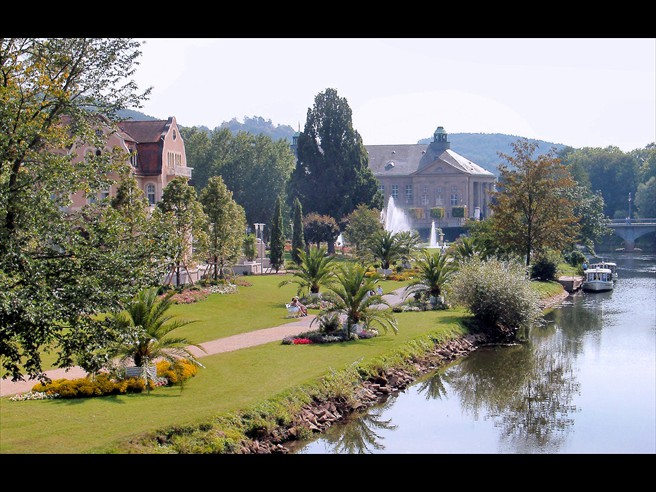
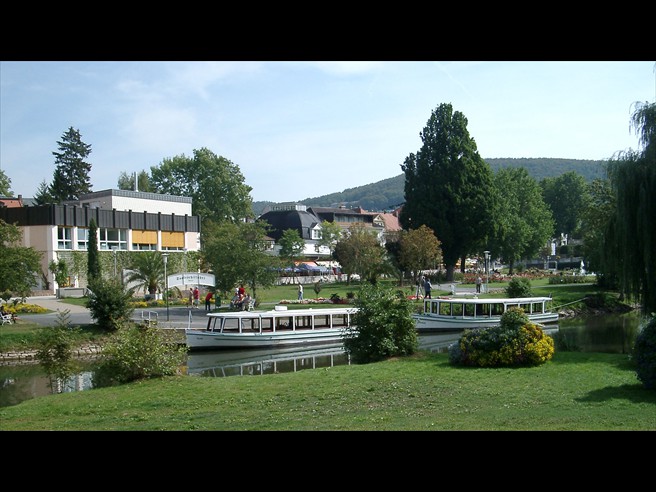
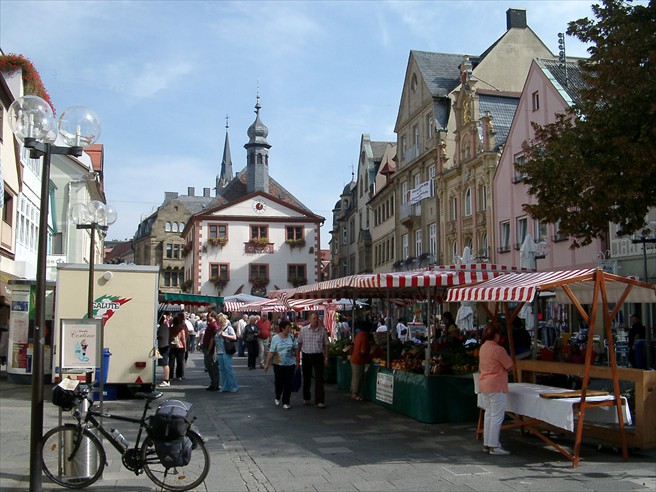
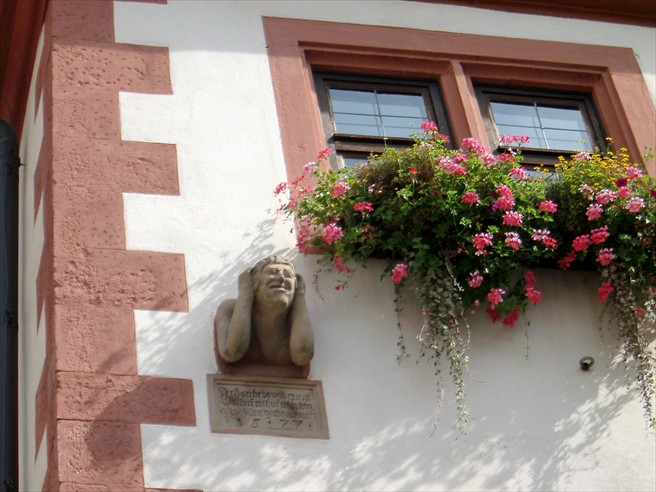
 I had lunch here
I had lunch here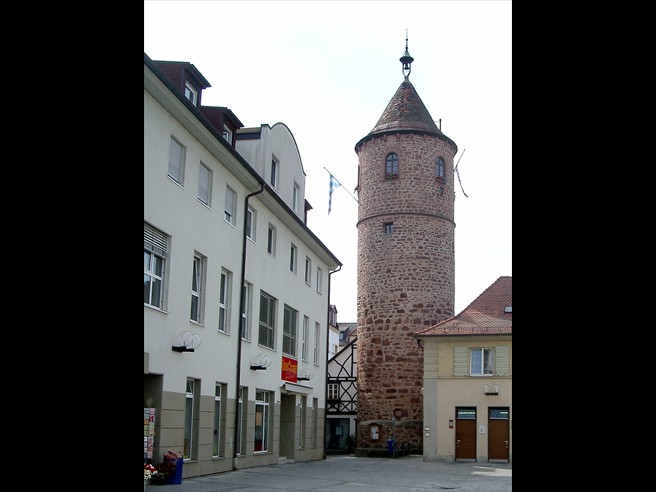 The fire tower is the only one left of the original 14 city towers
The fire tower is the only one left of the original 14 city towers